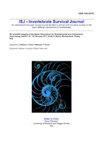Evaluating the implications of moisture deprivation on certain biochemical parameters of the earthworm Eudrilus eugeniae with microbial population and exoenzyme activities of the organic substrate
IF 1.2
4区 农林科学
Q4 IMMUNOLOGY
引用次数: 3
Abstract
Reduction in moisture in the top soil and decomposing organic substrate is likely to influence the epigeic earthworms along with the microbial population and exoenzyme secretions. This study reports the results of the effects of consistent moisture reduction in semidecomposed organic substrate on the tissue protein, lipid peroxidation and catalase activity of the earthworm Eudrilus eugeniae along with pH, organic carbon reduction, bacterial-fungal population, activities of exoenzymes, amylase, cellulase, invertase over an experimental period of 22 days. Consistent depletion in tissue protein, increase in lipid peroxidation level and catalase activity was observed in the earthworm with moisture depletion. Catalase activity indicated significant negative correlation with substrate moisture. Significant differences in the carbon reduction, microbial population, exoenzyme activities in the substrate was observed with reduction of moisture and with respect to control. Significant positive correlation was observed between percent substrate moisture with microbial population and activities cellulase. It was concluded that desiccation of decomposing organics could enhance physiological stress on the earthworm and adversely impact the microbial population, exoenzyme secretions, consequently impairing mineralization.利用微生物种群和有机底物外酶活性评价水分剥夺对原生蚯蚓某些生化参数的影响
表层土壤水分的减少和有机基质的分解可能会影响后生蚯蚓以及微生物种群和外泌酶的分泌。本研究报道了半分解有机底物持续减湿对eugenae蚯蚓组织蛋白、脂质过氧化和过氧化氢酶活性的影响,以及pH、有机碳还原、细菌-真菌种群、外胞酶、淀粉酶、纤维素酶和转化酶活性的影响。蚯蚓组织蛋白持续减少,脂质过氧化水平和过氧化氢酶活性增加。过氧化氢酶活性与底物湿度呈极显著负相关。在减少水分和对照的情况下,观察到底物的碳还原、微生物种群、外泌酶活性的显著差异。底物含水率与微生物数量和纤维素酶活性呈显著正相关。综上所述,分解有机物的干燥会增加蚯蚓的生理应激,对微生物种群和外泌酶分泌产生不利影响,从而损害矿化。
本文章由计算机程序翻译,如有差异,请以英文原文为准。
求助全文
约1分钟内获得全文
求助全文
来源期刊

ISJ-Invertebrate Survival Journal
IMMUNOLOGY-ZOOLOGY
CiteScore
2.10
自引率
0.00%
发文量
0
审稿时长
>12 weeks
期刊介绍:
Invertebrate Survival Journal (ISJ) is an international and open access journal devoted to prompt and innovative studies on the basic defense mechanisms in invertebrates, in particular with a view to identifying biotechnologies able to act against derived diseases and related economic damage.
Contributions will be mainly in the form of Letters to the Editor, Visions and Perspectives, Short Communications, Technical Reports, Research Reports, Review, Minireview and Reports of Meetings. Letters to the Editor can be commentaries or perspectives on invertebrate defence mechanisms or replies to the data published in ISJ.
 求助内容:
求助内容: 应助结果提醒方式:
应助结果提醒方式:


